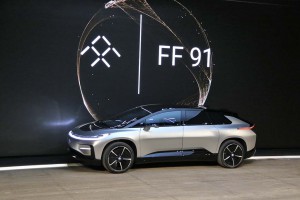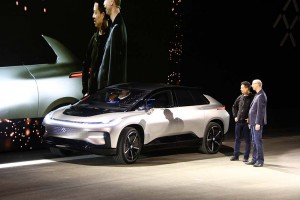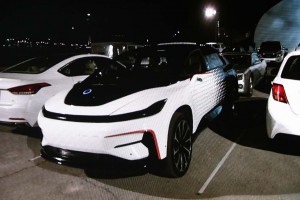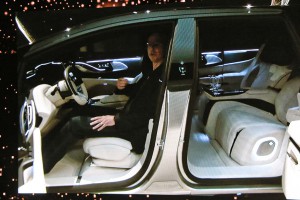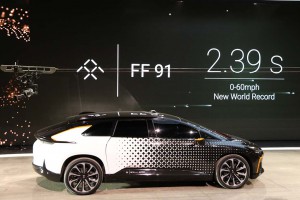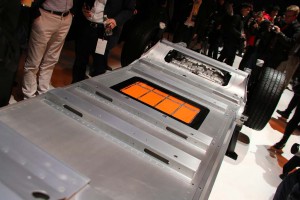The Future doesn’t always go as planned. Just ask YT Jia, the Chinese billionaire investor backing Faraday Future. That’s the California-based start-up that pulled the wraps off its new battery-electric supercar during a splashy, two-hour presentation in Las Vegas on Tuesday night.
Intentionally looking like it rolled off the set of a science fiction film, Faraday’s new FF91 battery-powered crossover certainly sounds impressive. It boasts more than 1,000 horsepower – enough to launch from 0 to 60 in less than 2.5 seconds. Yet it can also deliver an estimated 378 miles per charge. It also has the ability to drive hands-free, thanks to an array of radar, laser and other sensors. And, with a touch of button will let you get out and then go look for a parking spot on its own.
“It’s a vehicle that doesn’t require any sacrifice,” declared Pete Savagian, Faraday’s director of propulsion engineering. “Never has it been more convenient to drive completely electric.”
Or, at least it will be, if the FF91 does come to production, though due to a series of recent setbacks, that’s not entirely guaranteed. But the debut of the FF91 at the opening of the annual CES conference in Las Vegas largely sidestepped the problems facing Faraday Future to focus on a vehicle that could, indeed, be the prototype of tomorrow’s luxury car.
(Chrysler Portal Concept opens doors to Millennials. Click Here for a closer look.)
Intended to go up against such competitors as the Tesla Model X crossover-utility vehicle, and even the new Bentley Bentayga, the FF91 is a big beast, measuring about 206 inches, nose-to-tail. It boasts a 126-inch wheelbase and is 79 inches in width. It’s height varies, as its electronic control system can automatically adapt to your driving speed to maximize aerodynamics.
In fact, there are a number of active aero elements on the FF91, and for good reason, explained design director Richard Kim, noting that every “tick” you can reduce wind resistance “increases your range by 12 miles.”
So-called range anxiety has been one of the biggest drawbacks of battery propulsion, most of today’s electric vehicles limited to around 100 miles per charge. Tesla broke that paradigm with its Model S, initially delivering over 200 miles, and growing with each update of its battery pack. The Faraday FF91 promises to get to 378 miles using the EPA test, though it could reach nearly 500 miles at a steady 55 mph, according to Savagian.
To get there, Faraday Future has stuffed a massive 130 kilowatt-hour lithium-ion pack into the FF91’s platform. That’s 30% larger than the biggest pack currently offered by Tesla. The start-up claims that it also uses the highest-density lithium batteries available, the cells provided by Korea’s LG Chem. The pack itself, however, will be produced by Faraday itself.
An owner might need all that energy if they decide to push the FF91 to the limits. The battery powers up twin electric motors, one on each axle, making a combined 1,050 horsepower and what Savagian described as “an insane amount” of torque.
In a series of demonstrations, Faraday launched some of the world’s fastest cars, including the Ferrari 488 GTB and the Tesla Model S, as well as the FF91, down a track it had put together at the media event site. It also showed off the results of a more scientific track test that showed the Faraday battery car setting a new speed record for a (planned) production vehicle. It hit 60 in a blistering 2.39 seconds.
There won’t be many opportunities to test the limits, but in a world of increasingly dense traffic, the FF91 is equipped with 36 laser, ultrasonic, radar and vision sensors capable of letting the vehicle drive in either manual or fully autonomous mode. (The glowing LIDAR sensor that pops out of the hood is one of the car’s visual signatures.)
During one of the many demonstrations during the FF91 reveal, the car successful went looking for a parking spot on its own outside the big tent where the preview was held. As Savagian exited the vehicle, he tapped a button on his smartphone and the battery car circled until it found an empty spot, comfortably backing in between two other vehicles.
But things didn’t quite work out that way when money man Jia came on stage and tapped a sensor on the side of the car that was supposed to send it onto the stage where it would pose for pictures. It took an engineer to climb behind the wheel and reprogram a few settings before it would move. But it eventually did creep forward on its own, Jia declaring it, “amazing.”
Nick Sampson, the former Tesla engineer who is now Faraday’s executive vice president of engineering and, for all intents and purposes, the company’s top executive, downplayed the glitch as the stuff one can expect during the development of any automobile.
And were that the only setback Faraday is facing, the brief snag might be quickly forgotten. But there are a number of other setbacks. Just last week, it was revealed that Ding Lei, the unofficial CEO for the company – which has no formal chief executive – has resigned. That follows the departure of a number of other high- and mid-level managers and executives, including chief brand officer Marco Mattiacci, and product marketing chief Joerg Sommer.
Faraday has meanwhile been sued for unpaid bills by a handful of suppliers and is struggling to pay others, though a senior company insider, asking not to be identified by name, told TheDetroitBureau.com that, “We’re beginning to pay the bills” as new financing comes in. That will be critical, as a cash shortfall forced Faraday to halt work on the $1 billion assembly plant it is building in the desert north of Las Vegas.
(Is Faraday Future coming unplugged? Click Here for more on the company’s problems.)
Admitting there have been some rough moments, Sampson told the audience, “We will persist,” later telling TheDetroitBureau.com that work on the Nevada factory will resume “very soon.”
And, despite such setbacks, Faraday is confident enough to predict it will begin selling the FF91 sometime in 2018, though precisely when isn’t clear. Meeting that timetable would be a challenge for even the most established automaker, but Sampson brushed off such concerns, insisting Faraday has sidestepped the bureaucratic pitfalls of a classic car company. “Everything we achieved, we’ve achieved in a faster way, a different way.”
Potential customers, he noted, will now be able to place $5,000 deposits for the FF91 and, come March, a select group will be able to order the Alliance model, one of the first 300 battery-cars that will roll off the line. Half of the price of the vehicle will be donated to an as yet-unidentified environmental fund.
One slight problem is that Faraday hasn’t revealed the actual price of the FF91. Sampson would only suggest it will be “premium.” That could meant anywhere from around $90,000, roughly the starting price of a Mercedes-Benz S-Class or BMW 750i, to perhaps $200,000 or more.
Most observers anticipate something on the higher end of the scale considering all the features on the Faraday FF91. That also includes a high-tech interior using facial recognition and other sensors to recognize who gets into the vehicle and then set it up to their liking. That includes the music or videos they want, the FF91 being equipped with redundant antennas to ensure maximum connectivity, as well as an onboard WiFi system.
“It’s a connected ecosystem,” explained Sampson.
Who will want a car like the FF91 wasn’t directly addressed, nor would Faraday officials reveal production plans or sales goals. But they insist the company will be a “volume” manufacturer. And a more mainstream offering, they hinted, will follow the FF91 into production.
That is, of course, if Faraday really does have a future. The company has hit some real snags in recent months, and skeptics abound. But the Tuesday night event clearly showed that the FF91 is more than what is referred to as “vaporware” in Silicon Valley. There is a real car and, despite a brief hesitation, it appears to have some amazing capabilities. Now, Faraday has to survive long enough to put it into production.
(Connected car industry could be $130 bil business by 2019. Click Here for more.)

